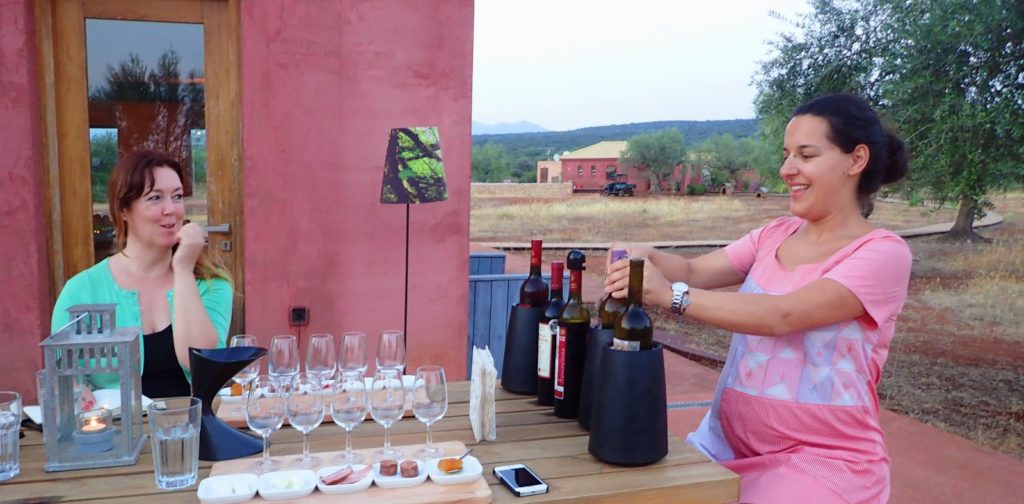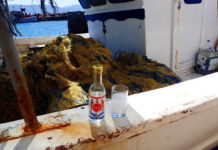Eumelia, this fabulous Bio-Dynamic universe I visited late last month, was so inspiring that ironically I have done pretty much nothing since then – at least nothing tangible. Nights of starry skies and afternoons full of the din of cicadas wipe out months of urban noise. The effect can be unnervingly profound.
Table of Contents
The Most Delightful Wine Tasting Ever
Does wine count as profound? Well, I’m starting to think so.
I have never learned, and loved, more about wine in a single evening than I did there at Eumelia on our first night. Our hosts, Frangiskos and Marilena, arranged a wine tasting – just for my friend Janet and me.
Given what I do and where I live, I taste a lot of wine. Sometimes it feels pretentious, sometimes genuinely interesting, but never is it just plain fun. That is because I never had a wine tasting with Marilena, who put all the delight back into something intended to be delightful, deepening our understanding along the way.

Perfect Pairings
We sat on the back patio, olive trees reaching as far as we could see into the distance until they were lost to the gathering darkness. Each of us had a board with five glasses lined up, and a small plate like a tapa in front of each one with its corresponding wine’s accompaniment – a feta, a local semi-hard crumbling goat cheese, some siglino (smoked pork), a rich cured sausage with plenty of orange zest from Mani, and a little bergamot peel simmered in sugar syrup until it shone like a jewel.
Compare and Contrast
It’s sometimes hard to get to central truth of something on its own. Comparison is a clearer route to understanding. For instance, there’s a room in the Metropolitan where you can walk back and forth, back and forth, comparing the brushwork of Frans Hals and the brushwork of Rembrandt.Once you have done this (like I was urged to do growing up), you get Hals the better, and you get Rembrandt the better, and you get them at 50 paces.I wanted to get more from wine – an available but sometimes elusive everyday pleasure.
How to Love Wine Better, in Five Simple Lessons:

I. Asproudi + Feta from Monemvasia: A tart, grassy white with a fresh, tangy, salty cheese
When we begin, there is still some light in the sky, and that’s a good thing because we are starting out with the whites, and color shapes our expectations. Our first wine is on the pale, cool, grassy end of the spectrum. The transparency of this is beautiful- “Fresh light colors signal fresh light flavors- tangyness, grassyness,” Marilena tells us. We look, then taste.Actually, we look, then sniff, then taste:“This is not exactly a savoir-vivre process. Put your nose right into the glass and sniff it – short, fast sniffs. Like a dog does.” We abandon inhibitions and sniff like dogs. “Now get some air in it, open your lips while you sniff.” The scent really unfolds with that tip, and it fits the look of the wine- unripe, fresh, sour, lots of fresh cut grass.Marilena says that smelling the wine is the most important step- the tongue tells us basic information- how sweet/sour/bitter something is, but it is actually the nose that tells us it is, say, an apricot. Now we sip, swish it everywhere around the mouth, frothing it around and getting some air into it, under and around the tongue, and the flavors are revealed.
“How acidic is it? Roll the wine far back on the sides of the tongue. Do you salivate? Yes? The wine is fresh, tangy.”
“Remember litmus paper in science class in school? Sour of course is acid. To balance acidity, we look for something alkaline- mineral- for example, salt. That’s why we have the feta- it’s a bright zingy wine and it can stand up to the salty bite of the cheese.”
“We want to balance the opposing properties of acid with alkaline, but we want to match intensity- bold wine goes with bold food, light with light, heavy with heavy. Pair the bright fresh Asproudi with a rich spicy meat, and the wine will simply disappear. Likewise, pair a strong red wine with some gemista (peppers stuffed with herbs and rice), and the food will disappear.”
We enjoy each of them more together than we would separately. And we enjoy every bit. There is a vessel to pour out unwanted wine. No one uses it.

II. Kidonitsa + Sfella (a semi-hard goat cheese):
A richer, more complex white with a stronger, older cheese.
The next wine is also a white- heavier, more golden, and delightfully named- the grape is “Kidonitsa,” which means “little quince.” Why is it special? It’s not just local to Laconia, but ancient and indigenous, and has only barely been rescued from extinction. It was here before the Ottomans came, and just a few vines somehow survived. As you would think with the history, there is some depth, complexity there- cherries, almonds, a beguiling hint of bitter in the after taste. In my notebook, I have scribbled: “¡¡¡ fun!”
This wine is less acidic, more alkaline, heavier and more intense, and with that edge of bitterness it needs something bolder to stand up to it- a crumbly goat cheese from Mani called sfella that we cannot get enough of and have for breakfast the next day with melon. The sfella tames the bitter edge of the wine; the Kidonitsa brings out the richness of the cheese.
III. Agiorgitkio + Siglino (smoked pork):
A fruity, straight-forward and not very tannic red with a meat.
Now we move on to a red, an Agiorgitiko- which I have drunk for years without ever associating the name with Saint George- Agios Giorgos- which is exactly what it is. It is a popular grape in Greece- a fruity red, soft, drinkable, not so very tannic, with strawberries and black cherries on the tongue. Usually a fruity red is a young red, but Marilena says this is “a tricky wine.” It is actually from 2008. Agiorgitiko is a great main course wine. The grape is a safe bet with red sauces, pork, and takes to the siglino well. It also sets us up nicely for the heaviest and most complicated of the wines-
IV. Mavroudi + Sausage with orange zest from Mani:
A complex, tannic red with a bold, spicy meat.
Mavroudi – which has the same DNA as the Asproudi we began with – is quite a wine. It absorbs all our attention: we go through the same process like we have with each wine- the looking, the sniffing, the swirling, but it takes longer because the wine is longer – long aroma, long aftertaste. You can feel it rolling out like a carpet. It goes through an interesting spectrum as it unfolds – fruits first, then heavier spices, then – “zoikotita”- a certain animal liveliness – barnyard giving way to meat. When that fades, there is an aftertaste of black olives, like those that will soon weigh down the branches of trees all around us.
The Mavroudi is tannic – so astringent it has us all smacking our tongue and our lips. Marilena reveals a brilliant simple truth:
Proteins cut tannins.
That’s why strong black tea takes well to milk, and why a rich tannic wine like this one calls out for meat. We bite into the sausage; the bold flavors tame the wine, the proteins tame the tannins, and it is nothing but balanced liveliness as we alternate bites with sips.
Did I mention how Caravaggio it has grown over the course of the first four wines?

Now it’s time for dessert.
V. Rosé + a homemade bergamot peel in syrup:
Semi-sweet with sweet, or semi-sweet with super-salty (like a Sauternes with brie).
This demi – sec rosé is delicious, complicated, from Agiogioritiko, Kydonitsa, Asyrtiko, and Moschofilero. We have it with some classic spoon sweet made by Ioanna- the complex aroma of the bergamot stands up to the wine. But Marilena says that, although usually we try to pair the characteristics of the wine with the food – like in this perfect match – it can be fun to go the other way and balance them. A salty cheese can be a wonderful pairing with a sweet wine. Contrasting in taste, but equal in intensity.
The stars have been growing brighter with every sip. Now we play- moving from one wine to another, pairing off different tastes, testing out the basics we have learned. Trees glow in the distance.
The wines we enjoyed were from two local producers, Theodorakakos, and Monemvasia.
Both are near Eumelia– a paradise so pristine and untouched you cannot imagine that it’s actually right in the middle of everything you would want to see. 45 minutes in any direction brings you to a new wonder- Monemvasia, or swimming in the turquoise waters of Mani and having a lobster macaroni by the sea in your damp bathing suit and a pareo, or the mountains of Taygetos, and ridiculously photogenic mountain villages. Then you come home and walk to your bio-dynamic chic bungalow under a blanket of stars so bright they outshine the moon.








